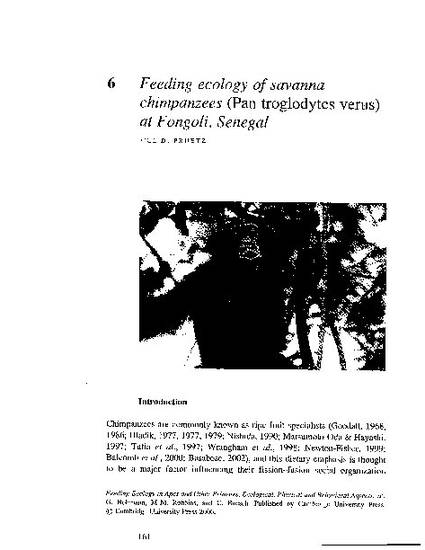
Contribution to Book
Feeding ecology of savanna chimpanzees at Fongoli, Senegal
The Feeding Ecology of Great Apes and other Primates
Document Type
Book Chapter
Disciplines
Publication Version
Published Version
Publication Date
1-1-2006
Abstract
Chimpanzees are commonly known as ripe fruit specialists (Goodall, 1968, 1986; Hladik, 1977, 1977, 1979; Nishida, 1990; Matsumoto-Oda & Hayashi, 1997; Tutin et al., 1997; Wrangham et al., 1998; Newton-Fisher, 1999; Balcomb et al., 2000; Basabose, 2002), and this dietary emphasis is thought to be a major factor influencing their fission-fusion social organization
(Wrangham, 1979; Sugiyama & Koman, 1992; Wrangham, 2000; NewtonFisher et al., 2000; Mitani et al., 2002; Lehmann & Boesch, 2004). In order to maximize their utilization of ripe fruit resources, which are generally described as patchy and variable in size (e.g., Ghiglieri, 1984 ), chimpanzee subgroups or parties fluctuate in size and individual make-up in response to resources. Presence of estrous females also influences the size and composition of chimpanzee parties, and this effect has been found to equate with food availability at some sites or even to surpass it (Goodall, 1986; Sakura, 1994; Boesch, 1996; Newton-Fisher et al., 2000; Anderson et al., 2002; Mitani et al., 2002).
Copyright Owner
Cambridge University Press
Copyright Date
2006
Language
en
File Format
application/pdf
Citation Information
Jill D. Pruetz. "Feeding ecology of savanna chimpanzees at Fongoli, Senegal" The Feeding Ecology of Great Apes and other Primates (2006) p. 161 - 182 Available at: http://works.bepress.com/jill-pruetz/21/

This is a chapter from The Feeding Ecology of Great Apes and other Primates (Cambridge Studies in Biological & Evolutionary Anthropology). C. Boesch, G. Hohmann, M. Robbins, eds., Cambridge Univ. Press (2006).